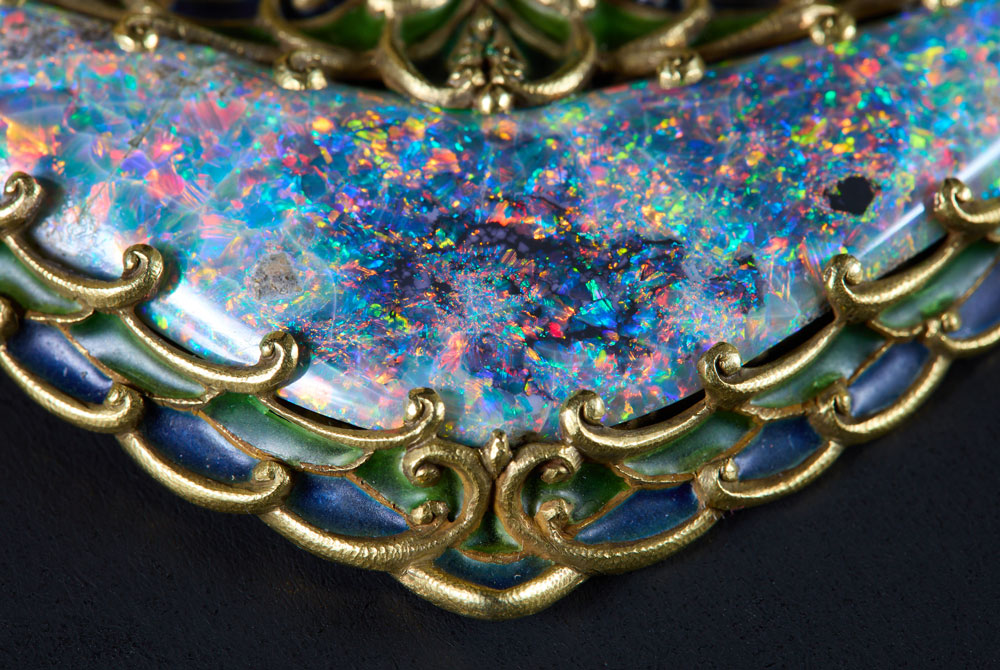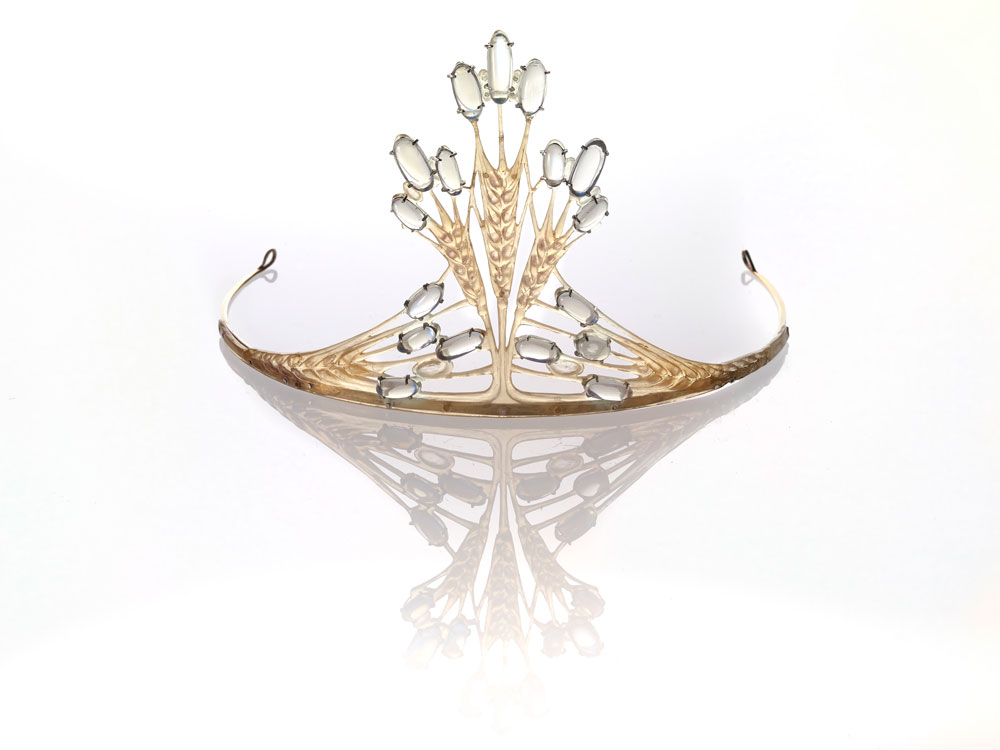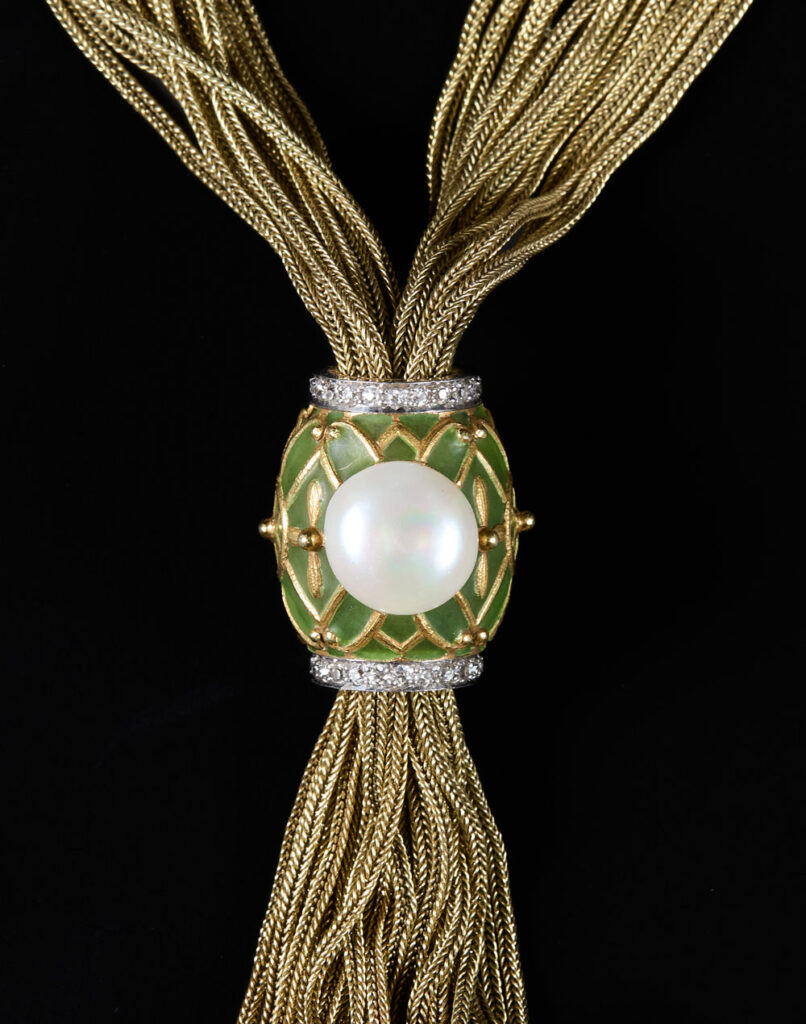
The desire to embellish or accentuate the body with jewelry extends deep into our ancestral past. According to a 2021 article by Sarah Cascone in ArtNet, archeologists discovered the world’s oldest jewelry in Morocco dating from 142,000 to 150,000 years ago. The set of 33 sea shell beads were found at the mouth of a cave 10 miles inland from the coastal city of Essaouira and it’s speculated that they were used to express identity through clothing.
Jewelry, like us, has come a long way since then. And even though beads are still very much in the mix, their significance is dwarfed by what we now consider fine jewelry. Jewelry made up of precious stones and metals. Like both fire and water, this higher form of jewelry can elicit a near primal fascination and it’s the star of the Driehaus Museum’s newest exhibition, Chicago Collects: Jewelry in Perspective, running through September 22nd.

Made up of 200 rare and historically significant objects gathered from private and institutional collections across Chicago, and spanning a timeframe from the 17th century to the 1970s, Chicago Collects escorts you through a world where craftsmanship and materials create the sensational. As the show’s title suggests, every piece in the exhibit has a strong Chicago connection. Either it is owned privately by someone residing in the city or it’s on loan from another Chicago museum or gallery. Nearly three quarters of the objects on display are from the estate of Richard H. Driehaus, the museum’s founder and legendary financier and philanthropist.
Curated by Elyse Zorn Karlin, who also oversaw the highly popular Maker and Muse: Women and 20th Century Art Jewelry exhibition at the museum in 2015, Chicago Collects carefully and clearly walks you through artistic approaches to jewelry styles across time. And although jewelry dominates the exhibition, other objects are also included to provide context and show how creative influences cross mediums of artistic expression.

Opulence and staggering beauty are common features of many of the pieces in the exhibition. Some derive from unexpected inspirations. A metalsmith and member of the Cliff Dwellers, a private Chicago club for artists, musicians, architects and writers; Robert Jarvie was commissioned to produce a custom item for the club. He eventually chose something that would reflect the club’s affinity for Native American motifs. Using sterling silver as his medium, in 1910 he presented the club with an extremely large and exceptionally resplendent punch bowl patterned after baskets woven by Ancestral Puebloans. Inhabiting a segment of the country where Colorado, Utah, Arizona and New Mexico meet, one of the unique aspects of the Puebloans is that parts of their community resided in dwellings carved into the cliffside.
Equally arresting in their subtle magnificence, a pair of pewter vases are also in the show highlighting the extraordinary craftsmanship coming out of Germany early in the 20th century.
The sweep and variety of items included in the show are startling. Wonderfully ornate daggers, a sumptuously jeweled golden timepiece that once belonged to a king, brilliantly designed tea and coffee sets, a jewel studded tabletop barometer, fancifully designed tiaras, lavishly decorated cigarette cases in precious metals and a tidal wave of jewelry created by the foremost designers in the world; including Louis Comfort Tiffany and Faberge, fill the exhibition.

Housed on the upper floors of the museum’s home, the Nickerson Mansion on Wabash and Erie, itself an emblem of the Gilded Age, Chicago Collects seems well placed to be seen in an environment accustomed to grandeur. Soaked in the warmth of polished wood, each room conveys an intimacy that encourages you to take your time and absorb how ingeniously art, craft and precious materials can combine to create splendor.
Tucked inside a small alcove and all alone stands the work of an artisan some call a genius. Although Rene’ Lalique began his career as a jeweler, he acquired overwhelming fame when he switched to glass. Often referred to as the glass poet, he drew his inspiration from both the natural world and the female form. Made of opalescent glass, The Suzanne Statuette he designed and created in 1925 and showcased in the exhibition’s alcove illustrates the ethereal mystery as well as beauty he brings to his work.
Among the glittering diamonds, rubies and pearls scattered throughout the gallery displaying some of the more contemporary objects were a number of surprising takes on ring design. Noted for their exaggerated proportions, the show’s monument rings combined large scale and fanciful whimsy to create their own category of unique. On another wall, big spiraling earrings flaunting bold futuristic design looked forward in time to put their stamp on how beauty might be defined. In this collection of Chicago treasures, the language of what is beautiful is spoken in over two hundred tongues. One of the summer’s more interesting past times might be to go listen to them with your eyes.
Chicago Collects: Jewelry in Perspective
Through September 22, 2024
The Richard H. Driehaus Museum
40 East Erie Street
Chicago, IL 60611